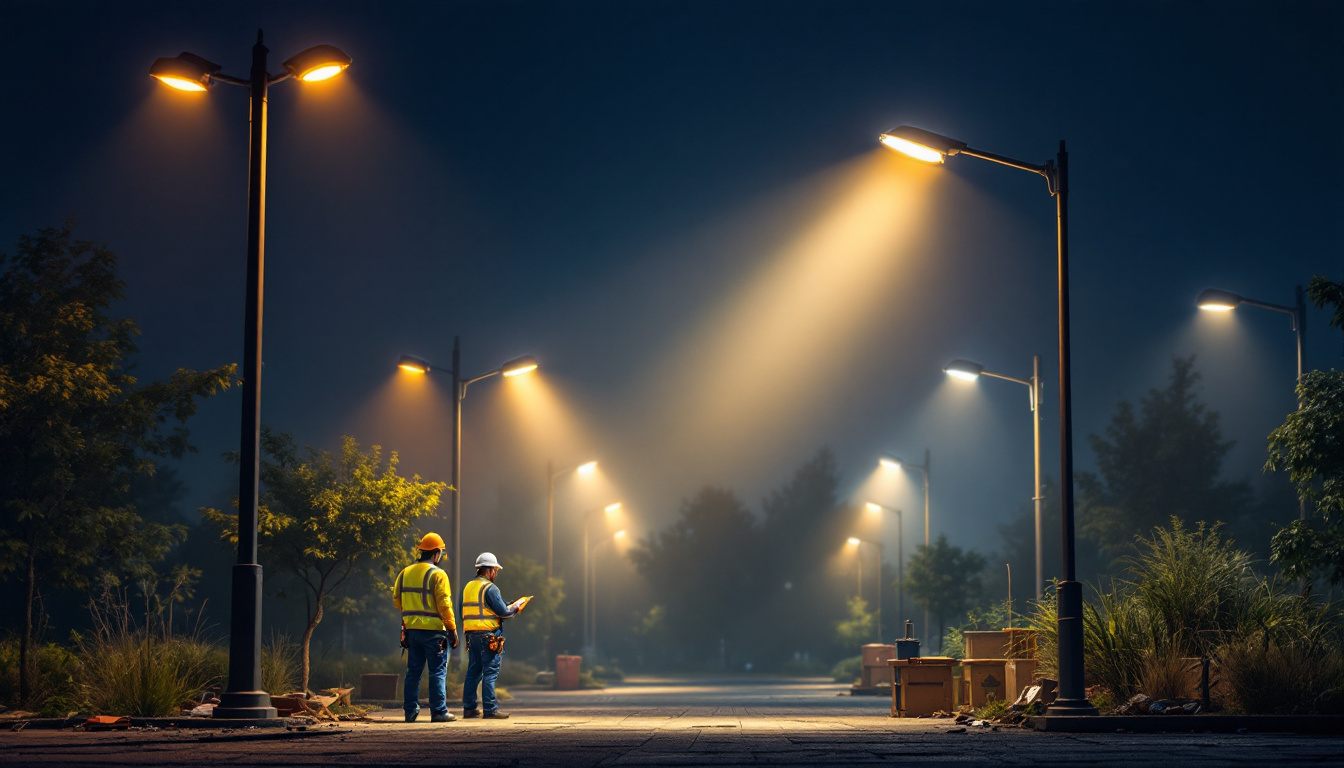
When it comes to outdoor lighting projects, especially those involving light poles, a systematic approach is vital for success. Lighting contractors must ensure that every aspect of the installation process is meticulously planned and executed. This checklist serves as a comprehensive guide for contractors, helping to streamline the process while ensuring safety, efficiency, and compliance with regulations.
Before diving into the installation, it is crucial to understand the specific requirements of the project. This phase involves gathering information and assessing the environment where the light poles will be installed.
A thorough site assessment is the foundation of any successful lighting project. Contractors should evaluate the terrain, existing structures, and potential obstacles that may affect light placement. This includes identifying areas that require more illumination and those that may need less, ensuring that the lighting is both effective and aesthetically pleasing.
Additionally, understanding the local climate can influence the choice of materials and lighting fixtures. Areas prone to high winds or heavy snowfall may require sturdier poles and fixtures designed to withstand harsh conditions. Furthermore, it is essential to consider the surrounding flora and fauna, as certain lighting can impact wildlife behavior. For instance, excessive brightness can disrupt nocturnal animals, so selecting fixtures with appropriate shielding can mitigate these effects while still providing the necessary illumination.
Engaging with the client is essential to align expectations and clarify project goals. Discussing the intended use of the lighting, whether for security, aesthetics, or functionality, will guide the selection of fixtures and pole heights. It’s also an opportunity to address any budget constraints and timeline expectations.
During this consultation, it’s beneficial to present various lighting options, including LED versus traditional bulbs, to help clients make informed decisions based on energy efficiency and maintenance costs. Additionally, exploring smart lighting solutions can be advantageous, as these systems allow for remote control and automation, providing flexibility and adaptability to changing needs. Clients may also appreciate discussing the potential for integrating renewable energy sources, such as solar panels, which can enhance sustainability and reduce long-term operational costs.
Once the requirements are clear, the next step is to design a lighting plan that meets both functional and aesthetic needs. This phase involves selecting the right equipment and determining the layout of the light poles.
The choice of lighting fixtures plays a significant role in the overall effectiveness of the installation. Factors to consider include brightness, energy consumption, and color temperature. LED fixtures are increasingly popular due to their longevity and energy efficiency, making them a preferred choice for many contractors.
Additionally, the design of the fixtures should complement the surrounding architecture and landscape. This consideration not only enhances the visual appeal but also ensures that the lighting serves its intended purpose without causing glare or light pollution.
A well-planned lighting layout is crucial for achieving uniform illumination. Contractors should utilize lighting design software or manual calculations to determine the optimal placement of light poles. The spacing between poles should be calculated based on the wattage of the fixtures and the desired light levels.
It’s also important to consider the height of the poles. Taller poles may be necessary in open areas to cover larger spaces, while shorter poles may suffice in more confined settings. This planning phase should also account for any potential future expansion of the lighting system.
Compliance with local regulations and codes is a non-negotiable aspect of any lighting installation. Contractors must familiarize themselves with the relevant laws to avoid costly fines and ensure the safety of the installation.
Before commencing installation, contractors should obtain all necessary permits. This often involves submitting detailed plans to local authorities for approval. The permitting process can vary significantly depending on the location and scope of the project, so it’s advisable to start this process early.
In addition to local permits, contractors should also verify that the fixtures and poles meet safety standards set by organizations such as Underwriters Laboratories (UL) or the American National Standards Institute (ANSI). Compliance with these standards ensures that the products used are safe and reliable.
In today’s environmentally conscious landscape, contractors should also consider the ecological impact of their lighting installations. This includes using fixtures that minimize light pollution and selecting materials that are sustainable and recyclable.
Moreover, contractors should be aware of any local wildlife regulations that may affect the installation. For example, in areas with significant bird populations, it may be necessary to choose fixtures that reduce the risk of disorientation for birds.
With planning and compliance in place, the actual installation can begin. This phase requires careful execution to ensure that the project is completed on time and within budget.
Preparing the site is a critical step before installing light poles. This may involve clearing the area of debris, leveling the ground, and marking the locations for each pole. Proper site preparation can prevent complications during installation and ensure that the poles are securely anchored.
Contractors should also consider the installation of electrical conduits at this stage. Ensuring that conduits are correctly laid out will facilitate the wiring of the fixtures and minimize the risk of damage during the installation process.
The installation of light poles should be conducted with precision. Contractors must follow the manufacturer’s instructions regarding pole assembly and anchoring. This often involves digging holes for the foundations, setting the poles in place, and securing them with concrete or other materials.
During this phase, it’s essential to maintain safety protocols. Proper lifting techniques and the use of personal protective equipment (PPE) can prevent accidents and injuries on the job site.
Once the poles are installed, the next step is to complete the electrical wiring and conduct thorough testing of the system. This phase is crucial for ensuring that the lighting functions as intended.
Contractors should follow all electrical codes when wiring the fixtures. This includes using the appropriate gauge wire and ensuring that all connections are secure and weatherproof. Proper wiring not only ensures safety but also enhances the longevity of the lighting system.
In addition, it’s advisable to install circuit breakers and fuses to protect the system from power surges. This precaution can save significant costs in repairs and replacements down the line.
After wiring is complete, contractors should conduct a comprehensive test of the lighting system. This involves checking each fixture to ensure it operates correctly and provides the desired level of illumination. Any issues should be addressed promptly to avoid complications once the project is completed.
During testing, it’s also important to evaluate the lighting for any unwanted glare or dark spots. Adjustments can be made at this stage to optimize the lighting layout before finalizing the installation.
Once the installation and testing phases are complete, a final inspection should be conducted. This step is crucial for ensuring that everything meets the established standards and client expectations.
A final walkthrough with the client allows for any last-minute adjustments and provides an opportunity to address any concerns. During this walkthrough, contractors should explain the operation of the lighting system, including any timers or sensors that have been installed.
It’s also a good time to discuss maintenance schedules and provide the client with documentation on the fixtures and warranties. This information will be invaluable for future upkeep and troubleshooting.
Documenting the project is essential for both the contractor and the client. This includes keeping records of permits, inspections, and warranties, as well as any changes made during the installation process. Proper documentation can protect contractors in the event of disputes and provide clients with peace of mind.
Moreover, this documentation can serve as a valuable reference for future projects, helping contractors to refine their processes and improve efficiency.
After the project is completed, ongoing maintenance is crucial for ensuring the longevity and effectiveness of the lighting system. Contractors should establish a maintenance plan that outlines regular inspections and necessary repairs.
Regular inspections help identify potential issues before they become significant problems. This can include checking for burnt-out bulbs, loose wiring, or structural damage to the poles. Scheduling these inspections at least twice a year can significantly extend the lifespan of the lighting system.
During inspections, contractors should also evaluate the overall performance of the lighting. Adjustments may be necessary to maintain optimal illumination levels, especially if surrounding landscaping has changed.
Educating clients on the importance of maintenance can foster a long-term relationship and ensure the continued success of the lighting system. Providing clients with a maintenance checklist and tips for troubleshooting minor issues can empower them to take an active role in the upkeep of their outdoor lighting.
Moreover, contractors should be available for support and questions, reinforcing their commitment to quality service and customer satisfaction.
Installing outdoor light poles is a multifaceted process that requires careful planning, execution, and ongoing maintenance. By following this comprehensive checklist, lighting contractors can ensure that their projects are successful, compliant, and meet the needs of their clients. From the initial site assessment to the final inspection and beyond, attention to detail and a commitment to quality will set contractors apart in a competitive industry.
Ultimately, a well-executed lighting installation not only enhances the safety and functionality of outdoor spaces but also contributes to the overall aesthetic appeal, making it a worthwhile investment for any property owner.
Ready to elevate your outdoor lighting installations with the highest quality products at the best value? Look no further than LumenWholesale. Our spec-grade lighting solutions are designed to meet the rigorous demands of any project, ensuring durability, performance, and aesthetic appeal. Say goodbye to inflated markups and hello to unbeatable wholesale prices, complemented by the convenience of free shipping. Don’t compromise on quality or cost—choose LumenWholesale for your next project and experience the ultimate in lighting excellence. Start browsing our selection now and take advantage of Wholesale Lighting at the Best Value.

Discover 5 key reasons why lighting contractors should prioritize pendant light tubes, boosting efficiency, aesthetics, and client satisfaction—learn how today!.

Discover expert insights on transforming spaces with recessed light conversion kits.

Discover why lighting contractors are turning to magnetic LED strips as a top choice for modern projects.

Discover how flush mount kitchen ceiling lights not only elevate your home’s aesthetic but also enhance safety in lighting installations.